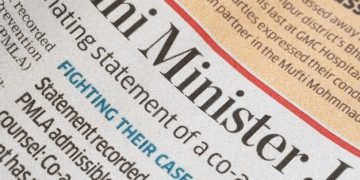How News Organizations Protect Individual Privacy: A Deep Dive

Anúncios
News organizations protect individual privacy through strict internal policies, anonymization techniques, secure data handling, legal compliance, and a commitment to ethical reporting, balancing public interest with personal rights.
Anúncios
In today’s digital age, the question of how do news organizations protect the privacy of individuals? is more critical than ever. With increasing data collection and sophisticated surveillance technologies, understanding the measures news outlets take to ensure personal information remains confidential is essential. This article delves into the strategies and practices that news organizations employ to balance their duty to inform the public with the imperative to protect individual privacy.
Understanding the Importance of Privacy in Journalism
The relationship between journalism and individual privacy is complex. On one hand, journalists have a responsibility to report on matters of public interest, which may sometimes involve revealing personal information. On the other hand, privacy is a fundamental right, and news organizations must take steps to avoid causing unnecessary harm or distress. Striking the right balance requires a deep understanding of ethical principles and legal frameworks.
Anúncios
Ethical Considerations
Journalists often face ethical dilemmas when reporting on sensitive topics. Disclosing someone’s personal information, even if it is factually accurate, can have serious consequences for that individual and their family. Therefore, news organizations must carefully consider the potential impact of their reporting and weigh it against the public interest.

Legal Frameworks
In addition to ethical considerations, news organizations must also comply with various legal frameworks designed to protect individual privacy. These laws vary from country to country, but they generally place restrictions on the collection, use, and disclosure of personal information. Understanding and adhering to these laws is crucial for maintaining public trust and avoiding legal repercussions.
- Data Protection Laws: Many countries have laws that regulate how organizations can collect, store, and use personal data.
- Defamation Laws: News organizations must be careful not to publish false or misleading information that could harm someone’s reputation.
- Right to Privacy: Some jurisdictions have laws that specifically protect an individual’s right to privacy, giving them the right to sue if their privacy is violated.
Ultimately, protecting privacy in journalism is about responsible reporting. It requires journalists to be mindful of the potential impact of their work and to take steps to minimize harm while still fulfilling their duty to inform the public. This balance is crucial for maintaining trust and ensuring that journalism serves the public interest.
Developing Internal Privacy Policies
A cornerstone of protecting individual privacy within news organizations is the development and enforcement of comprehensive internal privacy policies. These policies serve as guidelines for journalists and other staff members, outlining the acceptable use of personal information and the steps they must take to ensure confidentiality.
Components of a Strong Privacy Policy
An effective privacy policy should cover a wide range of issues, including data collection, storage, usage, and disclosure. It should also address issues such as anonymization, data security, and employee training. Regular reviews and updates are essential to ensure the policy remains relevant and effective.
Training and Awareness
A well-written policy is only as good as its implementation. News organizations must invest in training and awareness programs to ensure that all staff members understand the policy and their responsibilities. This may involve workshops, online training modules, and regular reminders about the importance of privacy.

- Regular Training Sessions: Conduct regular training sessions for all employees on data privacy and security best practices.
- Policy Updates: Keep the privacy policy up-to-date with the latest legal requirements and technological advancements.
- Compliance Checks: Periodically audit internal practices to ensure compliance with the privacy policy.
By developing and enforcing strong internal privacy policies, news organizations can create a culture of privacy awareness and ensure that individual rights are respected. This is essential for maintaining trust and fulfilling their ethical obligations.
Anonymization and Pseudonymization Techniques
One of the most effective ways news organizations can protect individual privacy is through anonymization and pseudonymization techniques. These methods involve altering data to make it more difficult to identify individuals, while still allowing journalists to report on important stories.
Understanding Anonymization
Anonymization is the process of removing all identifying information from a dataset, making it impossible to link the data back to a specific individual. This may involve removing names, addresses, phone numbers, and other personal identifiers. However, it is important to note that true anonymization can be difficult to achieve, as even seemingly innocuous data points can sometimes be used to re-identify individuals.
Using Pseudonymization
Pseudonymization involves replacing identifying information with pseudonyms or codes. This can make it more difficult to identify individuals directly, but it still allows researchers and journalists to analyze the data. Pseudonymization is often used in situations where complete anonymization is not possible or desirable, but where it is still important to protect individual privacy.
However, pseudonymization must be implemented carefully to avoid unintended re-identification. News organizations must ensure that the pseudonyms or codes used cannot be easily linked back to the original individuals. Regular audits and security measures are essential to maintain the integrity of the pseudonymization process.
By employing these techniques, news organizations can report on sensitive issues without putting individuals at risk. It requires a commitment to data security and a thorough understanding of the limitations of these methods.
Secure Data Handling and Storage
The security of data handling and storage is paramount when addressing how do news organizations protect the privacy of individuals? News organizations collect and store vast amounts of data, some of which may be highly sensitive. Protecting this data from unauthorized access, theft, or misuse requires robust security measures and protocols.
Encryption
Encryption is a fundamental tool for protecting data both in transit and at rest. It involves converting data into a coded format that can only be deciphered with a decryption key. This ensures that even if data is intercepted or stolen, it cannot be read by unauthorized individuals.
Access Controls
Limiting access to sensitive data is another crucial security measure. News organizations should implement strict access controls, ensuring that only authorized personnel have access to specific data sets. This may involve using passwords, multi-factor authentication, and regular audits of access logs.
Physical Security
In addition to digital security measures, news organizations must also consider physical security. This includes securing physical storage locations, such as servers and data centers, and implementing measures to prevent unauthorized access to these facilities. Regular security assessments and audits can help identify vulnerabilities and ensure that physical security measures are up to par.
- Regular Security Audits: Conduct regular security audits to identify and address vulnerabilities in data handling and storage systems.
- Employee Training: Train employees on data security best practices, including password management and phishing prevention.
- Incident Response Plan: Develop and implement an incident response plan to quickly address any data breaches or security incidents.
By implementing robust security measures, news organizations can minimize the risk of data breaches and ensure that individual privacy is protected. This requires a proactive approach and a commitment to ongoing security improvements.
Legal Compliance and Transparency
Adhering to legal requirements and maintaining transparency are essential aspects of how do news organizations protect the privacy of individuals? News organizations must comply with a range of laws and regulations designed to protect individual privacy, and they should be transparent about their data handling practices.
Complying with Data Protection Laws
Data protection laws, such as the General Data Protection Regulation (GDPR) in Europe and the California Consumer Privacy Act (CCPA) in the United States, impose strict requirements on how organizations collect, use, and disclose personal data. News organizations must understand and comply with these laws, which may involve obtaining consent from individuals before collecting their data, providing them with access to their data, and allowing them to request that their data be deleted.
Being Transparent About Data Practices
Transparency is crucial for building trust with the public. News organizations should be transparent about their data handling practices, including what data they collect, how they use it, and who they share it with. This may involve publishing a privacy policy that is easily accessible on their website and providing individuals with clear and concise information about their rights.
By being transparent about their data practices, news organizations can demonstrate their commitment to protecting individual privacy and build stronger relationships with their audience. This requires a proactive approach and a willingness to engage in open and honest communication.
Balancing Public Interest vs. Individual Privacy
The core challenge in addressing how do news organizations protect the privacy of individuals? is balancing the public interest with the right to individual privacy. News organizations have a responsibility to report on matters of public concern, but they must also avoid causing unnecessary harm or distress to individuals.
Assessing the Public Interest
When deciding whether to publish personal information, news organizations should carefully assess the public interest. This involves considering the importance of the story, the potential impact on the public, and the extent to which the information is already in the public domain. In some cases, the public interest may outweigh the need to protect individual privacy, but this should only be done after careful consideration and with appropriate safeguards in place.
Minimizing Harm
Even when publishing information that is in the public interest, news organizations should take steps to minimize potential harm to individuals. This may involve anonymizing data, redacting sensitive information, or providing individuals with an opportunity to respond to allegations before publication.
- Redaction: Carefully redact sensitive information that is not essential to the story.
- Right to Respond: Give individuals the opportunity to respond to allegations or provide context before publication.
- Avoid Sensationalism: Avoid sensationalizing stories or using inflammatory language that could cause unnecessary harm.
Striking the right balance between public interest and individual privacy is a complex and ongoing challenge. News organizations must be guided by ethical principles, legal frameworks, and a commitment to responsible reporting.
| Key Aspect | Brief Description |
|---|---|
| 🔒 Privacy Policies | Guidelines for handling personal information ethically and legally. |
| 🛡️ Anonymization | Techniques to remove identifying information, enhancing privacy. |
| 📊 Data Security | Secure data storage and encryption to prevent breaches. |
| ⚖️ Legal Compliance | Adherence to laws like GDPR and CCPA for data protection. |
Frequently Asked Questions
▼
Encryption converts data into a coded format, securing it from unauthorized access. This is crucial for protecting sensitive information during storage and transmission, ensuring only those with the decryption key can read it.
▼
Transparency builds trust with the public. By openly communicating their data handling practices, news organizations show their commitment to protecting privacy and fostering a stronger relationship with their audience through honesty.
▼
Data protection laws, like GDPR and CCPA, mandate how personal data can be collected, used, and disclosed. News organizations must comply with these laws, including obtaining consent and allowing individuals to access or delete their data.
▼
To minimize harm, news organizations can employ anonymization, redact sensitive information, and give individuals the chance to respond before publication. Avoiding sensationalized language is another critical step in responsible reporting.
▼
Internal privacy policies serve as guidelines for all staff, outlining acceptable use of personal information and ensuring confidentiality. They promote a culture of privacy awareness and guarantee that individual rights are respected within the organization.
Conclusion
Protecting individual privacy is a critical responsibility for news organizations. By implementing robust policies, utilizing anonymization techniques, ensuring secure data handling, and maintaining transparency, news outlets can balance their duty to inform the public with the imperative to safeguard personal information and build trust with their audience.





